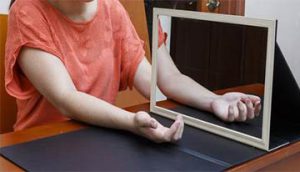Mirror Therapy for Neuropathic Pain
Neuropathic pain impacts negatively on many areas of life. On top of the obvious limitations created by pain, it also causes psychological problems resulting in sleep disorders, anxiety and depression. Other consequences associated with neuropathic pain are deterioration in sexual and marital life and family relationships which lead to social isolation. Although numerous pharmacological treatment options are available for relieving neuropathic pain, there is no consensus on the most appropriate treatment. The effective treatment of this type of pain is still a challenge and many people are left dissatisfied.
Mirror Therapy is one option to relieve neuropathic pain. Most other treatments involve taking multiple strong medications which have many other side effects. Using mirror therapy can allow you to manage your pain without having to rely on medications as it is not invasive. The appeal of mirror therapy is that it is simple, less labour intensive, and less expensive than other types of intervention. Evidence suggests that it can reduce pain in a wide range of neurological disorders such as phantom pain, pain from stroke or other brain injury or lesion, complex regional pain syndrome (CRPS) and possibly, peripheral nerve injury. This shows it is effective for both central and peripheral neuropathy.
 To use mirror therapy, the affected limb is placed behind a mirror and the reflection of the other limb moving is witnessed. The brain is “tricked” by this optical illusion and thinks your affected arm is moving without pain. It is thought that this works by “re-organising” the brain.
To use mirror therapy, the affected limb is placed behind a mirror and the reflection of the other limb moving is witnessed. The brain is “tricked” by this optical illusion and thinks your affected arm is moving without pain. It is thought that this works by “re-organising” the brain.
In neuropathic pain, changes are seen within the brain and the rest of the nervous system. Neuroplastic changes in the central descending pathway which normally dampens down pain no longer performs its function and may lead hyperexcitability which causes increased pain. Studies have shown evidence of brain reorganization that paralleled clinical improvement after using mirror therapy in patients with neuropathic pain.
It is recommended to start using mirror therapy as soon as possible after an injury. Reorganization of the brain after injury happens quite quickly. Persistent, chronic altered sensation may result in irreversible brain changes. At first it may only be possible to carry out very small movements with the non-affected limb and witness them in the mirror. As pain decreases you should be able to try to carry out small movements with both limbs. Once this becomes easy the movements can be made bigger and more complicated.
For example, for a peripheral nerve injury to the left hand, the left hand would be placed behind the mirror. Start with just bending and straightening the fingers of your right hand. Once it is easy to do, progress this movement with both hands. Then again, once this is easy, progress to making a fist with both hands. This can even be advanced to reach for and picking up a cup.
To find out more about the Mirror Therapy Rehab Kit or to purchase it, click here.